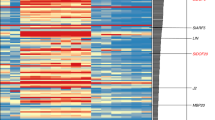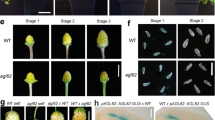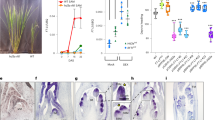Abstract
Anther dehiscence determines successful sexual reproduction of flowering plants through timely release of pollen grains for pollination and fertilization. Downregulation of auxin levels during pollen mitosis is essential for promoting anther dehiscence along with pollen maturation. How this key transition of auxin levels is regulated in male organs remains elusive. Here, we report that the rice FT-INTERACTING PROTEIN 7 is highly expressed in anthers before pollen mitotic divisions and facilitates nuclear translocation of a homeodomain transcription factor, Oryza sativa homeobox 1, which directly suppresses a predominant auxin biosynthetic gene, OsYUCCA4, during the late development of anthers. This confers a key switch of auxin levels between meiosis of microspore mother cells and pollen mitotic divisions, thus controlling the timing of anther dehiscence during rice anthesis. Our findings shed light on the mechanism of hormonal control of anther dehiscence, and provide a new avenue for creating hormone-sensitive male sterile lines for hybrid plant breeding.
This is a preview of subscription content, access via your institution
Access options
Access Nature and 54 other Nature Portfolio journals
Get Nature+, our best-value online-access subscription
$29.99 / 30 days
cancel any time
Subscribe to this journal
Receive 12 digital issues and online access to articles
$119.00 per year
only $9.92 per issue
Buy this article
- Purchase on Springer Link
- Instant access to full article PDF
Prices may be subject to local taxes which are calculated during checkout






Similar content being viewed by others
Change history
02 November 2018
In the version of this Article originally published, an incorrect immunoblot was used in the left, middle panel of Fig. 6a, which describes α-tubulin expression in whole-cell extracts. This panel, and the corresponding quantitative result shown in Supplementary Fig. 11e, have now been corrected in the Article. This does not affect the results or conclusions of this work.
References
Wilson, Z. A., Song, J., Taylor, B. & Yang, C. The final split: the regulation of anther dehiscence. J. Exp. Bot. 62, 1633–1649 (2011).
Ma, H. Molecular genetic analyses of microsporogenesis and microgametogenesis in flowering plants. Annu. Rev. Plant Biol. 56, 393–434 (2005).
Ishiguro, S., Kawai-Oda, A., Ueda, J., Nishida, I. & Okada, K. The DEFECTIVE IN ANTHER DEHISCENCE1 gene encodes a novel phospholipase A1 catalyzing the initial step of jasmonic acid biosynthesis, which synchronizes pollen maturation, anther dehiscence, and flower opening in Arabidopsis. Plant Cell 13, 2191–2209 (2001).
Sanders, P. M. et al. The Arabidopsis DELAYED DEHISCENCE1 gene encodes an enzyme in the jasmonic acid synthesis pathway. Plant Cell 12, 1041–1061 (2000).
Stintzi, A. The Arabidopsis male-sterile mutant, opr3, lacks the 12-oxophytodienoic acid reductase required for jasmonate synthesis. Proc. Natl Acad. Sci. USA 97, 10625–10630 (2000).
Devoto, A. et al. COI1 links jasmonate signalling and fertility to the SCF ubiquitin–ligase complex in Arabidopsis. Plant J. 32, 457–466 (2002).
Xie, D.-X., Feys, B. F., James, S., Nieto-Rostro, M. & Turner, J. G. COI1: an Arabidopsis gene required for jasmonate-regulated defense and fertility. Science 280, 1091–1094 (1998).
Sanders, P. M. et al. Anther developmental defects in Arabidopsis thaliana male-sterile mutants. Sex. Plant Reprod. 11, 297–322 (1999).
Nagpal, P. et al. Auxin response factors ARF6 and ARF8 promote jasmonic acid production and flower maturation. Development 132, 4107–4118 (2005).
Cheng, Y., Dai, X. & Zhao, Y. Auxin biosynthesis by the YUCCA flavin monooxygenases controls the formation of floral organs and vascular tissues in Arabidopsis. Genes Dev. 20, 1790 (2006).
Cecchetti, V., Altamura, M. M., Falasca, G., Costantino, P. & Cardarelli, M. Auxin regulates Arabidopsis anther dehiscence, pollen maturation, and filament elongation. Plant Cell 20, 1760–1774 (2008).
Tabata, R. et al. Arabidopsis AUXIN RESPONSE FACTOR6 and 8 regulate jasmonic acid biosynthesis and floral organ development via repression of class 1 KNOX genes. Plant Cell Physiol. 51, 164–175 (2010).
Cecchetti, V. et al. Auxin controls Arabidopsis anther dehiscence by regulating endothecium lignification and jasmonic acid biosynthesis. Plant J. 74, 411–422 (2013).
Cecchetti, V. et al. An auxin maximum in the middle layer controls stamen development and pollen maturation in Arabidopsis. New Phytol. 213, 1194–1207 (2017).
Zhao, Z. et al. A role for a dioxygenase in auxin metabolism and reproductive development in rice. Dev. Cell 27, 113–122 (2013).
Liu, L., Zhu, Y., Shen, L. & Yu, H. Emerging insights into florigen transport. Curr. Opin. Plant Biol. 16, 607–613 (2013).
Liu, L., Li, C., Liang, Z. & Yu, H. Characterization of multiple C2 domain and transmembrane region proteins in Arabidopsis. Plant Physiol. 176, 2119–2132 (2018).
Feng, Z. et al. Multigeneration analysis reveals the inheritance, specificity, and patterns of CRISPR/Cas-induced gene modifications in Arabidopsis. Proc. Natl Acad. Sci. USA 111, 4632–4637 (2014).
Song, S. et al. OsFTIP1-mediated regulation of florigen transport in rice is negatively regulated by the ubiquitin-like domain kinase OsUbDKγ4. Plant Cell 29, 491–507 (2017).
Liu, L. et al. FTIP1 is an essential regulator required for florigen transport. PLoS Biol. 10, e1001313 (2012).
Zhang, D. & Wilson, Z. A. Stamen specification and anther development in rice. Chin. Sci. Bull. 54, 2342–2353 (2009).
Zhang, D., Luo, X. & Zhu, L. Cytological analysis and genetic control of rice anther development. J. Genet. Genom. 38, 379–390 (2011).
Giordano, F. et al. PI(4,5)P(2)-dependent and Ca2+-regulated ER-PM interactions mediated by the extended synaptotagmins. Cell 153, 1494–1509 (2013).
Zhao, Y. Auxin biosynthesis and its role in plant development. Annu. Rev. Plant Biol. 61, 49–64 (2010).
Korasick, D. A., Enders, T. A. & Strader, L. C. Auxin biosynthesis and storage forms. J. Exp. Bot. 64, 2541–2555 (2013).
Yamamoto, Y., Kamiya, N., Morinaka, Y., Matsuoka, M. & Sazuka, T. Auxin biosynthesis by the YUCCA genes in rice. Plant Physiol. 143, 1362–1371 (2007).
Ulmasov, T., Murfett, J., Hagen, G. & Guilfoyle, T. J. Aux/IAA proteins repress expression of reporter genes containing natural and highly active synthetic auxin response elements. Plant Cell 9, 1963–1971 (1997).
Tsuda, K., Ito, Y., Sato, Y. & Kurata, N. Positive autoregulation of a KNOX gene is essential for shoot apical meristem maintenance in rice. Plant Cell 23, 4368–4381 (2011).
Burglin, T. R. Analysis of TALE superclass homeobox genes (MEIS, PBC, KNOX, Iroquois, TGIF) reveals a novel domain conserved between plants and animals. Nucleic Acids Res. 25, 4173–4180 (1997).
Sentoku, N., Sato, Y. & Matsuoka, M. Overexpression of rice OSH genes induces ectopic shoots on leaf sheaths of transgenic rice plants. Dev. Biol. 220, 358–364 (2000).
Tsuda, K., Kurata, N., Ohyanagi, H. & Hake, S. Genome-wide study of KNOX regulatory network reveals brassinosteroid catabolic genes important for shoot meristem function in rice. Plant Cell 26, 3488–3500 (2014).
Bolduc, N. & Hake, S. The maize transcription factor KNOTTED1 directly regulates the gibberellin catabolism gene ga2ox1. Plant Cell 21, 1647–1658 (2009).
Goldberg, R. B., Beals, T. P. & Sanders, P. M. Anther development: basic principles and practical applications. Plant Cell 5, 1217 (1993).
Reeves, P. H. et al. A regulatory network for coordinated flower maturation. PLoS Genet. 8, e1002506 (2012).
Cole, M., Nolte, C. & Werr, W. Nuclear import of the transcription factor SHOOT MERISTEMLESS depends on heterodimerization with BLH proteins expressed in discrete sub-domains of the shoot apical meristem of Arabidopsis thaliana. Nucleic Acids Res. 34, 1281–1292 (2006).
Rutjens, B. et al. Shoot apical meristem function in Arabidopsis requires the combined activities of three BEL1-like homeodomain proteins. Plant J. 58, 641–654 (2009).
Chen, L. & Liu, Y.-G. Male sterility and fertility restoration in crops. Annu. Rev. Plant Biol. 65, 579–606 (2014).
Kuroda, M., Kimizu, M. & Mikami, C. A simple set of plasmids for the production of transgenic plants. Biosci. Biotechnol. Biochem. 74, 2348–2351 (2010).
Toki, S. et al. Early infection of scutellum tissue with Agrobacterium allows high‐speed transformation of rice. Plant J. 47, 969–976 (2006).
Liu, C. et al. Specification of Arabidopsis floral meristem identity by repression of flowering time genes. Development 134, 1901–1910 (2007).
Li, D. et al. A repressor complex governs the integration of flowering signals in Arabidopsis. Dev. Cell 15, 110–120 (2008).
Saleh, A., Alvarez-Venegas, R. & Avramova, Z. An efficient chromatin immunoprecipitation (ChIP) protocol for studying histone modifications in Arabidopsis plants. Nat. Protoc. 3, 1018–1025 (2008).
Liu, S., Chen, W., Qu, L., Gai, Y. & Jiang, X. Simultaneous determination of 24 or more acidic and alkaline phytohormones in femtomole quantities of plant tissues by high-performance liquid chromatography–electrospray ionization–ion trap mass spectrometry. Anal. Bioanal. Chem. 405, 1257–1266 (2013).
Acknowledgements
We thank Z. He and J.-K. Zhu for providing the BAC clone and psgR-CAS9-Os vector, and members of the Yu lab for discussion and comments on the manuscript. This work was supported by the Singapore National Research Foundation Investigatorship Programme (NRF-NRFI2016-02), the National Natural Science Foundation of China (grant no. 31529001), the Ministry of Education and Bureau of Foreign Experts of China (grant B14027), and the intramural research support from National University of Singapore and Temasek Life Sciences Laboratory.
Author information
Authors and Affiliations
Contributions
S.S., Y.C. and H.Y. conceived the project; S.S. and Y.C. performed most of the experiments; L.L. participated in investigating the link between OsFTIP7 and OSH1; Y.H.B.S. conducted part of the rice transformation. S.S. and Y.C. conducted all statistical analyses; S.S., Y.C., C.M., Y.G. and H.Y. analysed data; S.S., Y.C. and H.Y. wrote the paper.
Corresponding author
Ethics declarations
Competing interests
The authors declare no competing interests.
Additional information
Publisher’s note: Springer Nature remains neutral with regard to jurisdictional claims in published maps and institutional affiliations.
Supplementary information
Supplementary Information
Supplementary Figures 1–13 and Supplementary Tables 1–3
Rights and permissions
About this article
Cite this article
Song, S., Chen, Y., Liu, L. et al. OsFTIP7 determines auxin-mediated anther dehiscence in rice. Nature Plants 4, 495–504 (2018). https://doi.org/10.1038/s41477-018-0175-0
Received:
Accepted:
Published:
Issue Date:
DOI: https://doi.org/10.1038/s41477-018-0175-0
This article is cited by
-
Rewiring of a KNOXI regulatory network mediated by UFO underlies the compound leaf development in Medicago truncatula
Nature Communications (2024)
-
Genetic diversity of grain yield traits and identification of a grain weight gene SiTGW6 in foxtail millet
Theoretical and Applied Genetics (2024)
-
Characterization and phylogenetic analysis of multiple C2 domain and transmembrane region proteins in maize
BMC Plant Biology (2022)
-
Comparative transcriptome analysis of pollen and anther wall reveals novel insights into the regulatory mechanisms underlying anther wall development and its dehiscence in rice
Plant Cell Reports (2022)
-
Evolution and diversity of the angiosperm anther: trends in function and development
Plant Reproduction (2021)



